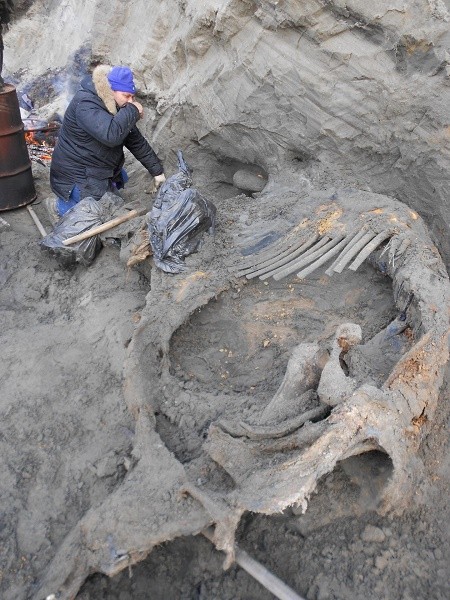By Ana Verayo, | January 15, 2016

In this photo, Sergey Gorbunov is excavating the mammoth carcass.
New evidence from a frozen carcass belonging to a woolly mammoth was uncovered in Siberia, that shows obvious signs of spear inflicted wounds suggesting that the Arctic regions were apparently inhabited by early humans 10,000 years earlier than first thought.
Like Us on Facebook
Russian scientists revealed how this male mammoth was discovered on Yenisei Bay located in the Arctic ocean, where hunters killed this majestic beast some 45,000 years back, that is now regarded as the earliest evidence of human presence in the Arctic region.
According to senior researcher, Vladimir Pitulko from the Russian Academy of Sciences in St. Petersburg, the oldest evidence of humans living in the Arctic were dated back to around 30,000 years ago, until this new study. He adds that these early humans who lived on the freezing Arctic were also hunter gatherers. And for those early humans, mammoths, that are close elephant relatives and the largest creatures to walk Earth during that time, are considered to be one of the most important sources for them.
They can provide food with their meat, fat and marrow, their waste can also be used as fuel along with fat and bones and their long bones and ivory can be used as dry goods, says Pitulko.
These hunter gatherers would use mammoth parts apart from the meat, such as the tongue or liver as some sort of delicacy, however, hunting them for ivory was more crucial since ivory replaced wood in this tundra and steppe landscape.
The mammoth was first excavated in 2012, where researchers spotted telltale signs of injuries, suggesting that it was killed by humans. Rib damage were supposedly caused by spears that were thrown by hunters, where its shoulder blade and cheekbone wounds indicated spears that were thrusted by hand, says Pitulko.
The right tusk also sustained severe damage that is most likely inflicted upon by humans after it was sawed or chopped off after killing the mammoth. Pitulko believes that this is undeniable evidence of humans killing this mammoth.
Now, scientists also consider that hunting mammoths has been a critical factor in helping early humans survive this harsh, frigid environment in the Arctic and along northern Siberia where these hunter gatherers finally reached their destination located at the Bering land bridge, connecting them from Siberia to Alaska.
The first humans that arrived in North America and through the Americas were those hunter gatherers who were originally from Siberia and the Arctic region, eventually crossing this land bridge.
This new study is published in the journal Science.
-
Use of Coronavirus Pandemic Drones Raises Privacy Concerns: Drones Spread Fear, Local Officials Say

-
Coronavirus Hampers The Delivery Of Lockheed Martin F-35 Stealth Fighters For 2020

-
Instagram Speeds Up Plans to Add Account Memorialization Feature Due to COVID-19 Deaths

-
NASA: Perseverance Plans to Bring 'Mars Rock' to Earth in 2031

-
600 Dead And 3,000 In The Hospital as Iranians Believed Drinking High-Concentrations of Alcohol Can Cure The Coronavirus

-
600 Dead And 3,000 In The Hospital as Iranians Believed Drinking High-Concentrations of Alcohol Can Cure The Coronavirus

-
COVID-19: Doctors, Nurses Use Virtual Reality to Learn New Skills in Treating Coronavirus Patients







